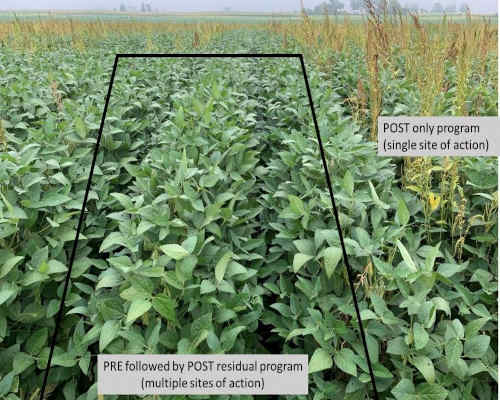By Prashant Jha
The following is a brief summary of new products available for weed control in corn and soybean in 2021. None of these are new sites of action herbicides, but are new premixes or revised formulations of existing active ingredients. With growing concerns of weeds developing resistance to herbicides, especially waterhemp with confirmed 4-5 way resistance to herbicide groups, HGs 2 (ALS inhibitors), 5 (atrazine), 9 (glyphosate), 14 (PPO inhibitors), and/or 27 (HPPD inhibitors) in Iowa corn and soybean fields (2019 survey), it is important to consider multiple effective sites of action herbicides both in postemergence and preemergence (soil residual) herbicide programs.
Impact core from Amvac contains topramezone + acetochlor (HG 27 + 15) is a new product labeled for postemergence weed control in corn.
Sinnate from Amvac is a premix of topramezone + glufosinate (HG 27 + HG 10) and will be available for postemergence weed control in Liberty Link corn.
Perpetuo from Valent contains pyroxasulfone + flumiclorac (HG 15 + 14) labeled for annual grass and broadleaf control in soybean.
Reviton from Helm Agro is a new HG 14 herbicide containing the active ingredient Tergeo (tiafenacil) labeled for preplant burndown weed control in corn and soybean.
Kyber is a new product from Corteva containing flumioxazin + metribuzin + pyroxasulfone (HG 14 + 5 + 15) labeled for preemergence weed control in soybean.
Tough 5 EC from Belchim Crop Protection containing pyridate (HG 6) is a new contact postemergence broadleaf herbicide registered for use in corn.
Antares Complete from Helena contains metribuzin + sulfentrazone + s-metolachlor (HG 5 + 14 + 15) labeled for preemergence weed control in soybean.
Empyros from Helena contains topyralate + s-metolachlor (HG 27 + 15) labeled for preemergence/early postemergence weed control in corn.
ZoneDefence is a new product from Helm Agro containing sulfentrazone + flumioxazin (HG 14) labeled for preemergence/preplant weed control in soybean.
AcuronXR and Acuron FlexiXR are bicyclopyrone (HG 27)-based premixes containing 3-4 sites of action for preemergence weed control in corn with anticipated launch in 2021.

Figure. Glyphosate-resistant waterhemp in a soybean field near Ames, IA 2020.
Enlist E3 soybean allows over-the-top applications of 2,4-D choline (Enlist One), glufosinate, and glyphosate. Use restrictions are similar to last year. Based on our field trials, tank-mixing Enlist One with glufosinate provides more consistent control of waterhemp compared to the products applied alone. Additionally, this strategy uses multiple sites of action to avoid resistance development to 2,4-D/glufosinate.
Xtend soybean are resistant to dicamba and glyphosate. XtendFlex soybean available for 2021 confers resistance to over-the-top applications of dicamba, glufosinate, and glyphosate. XtendiMax with VaporGrip, Engenia, FeXapan plus VaporGrip, and Tavium plus VaporGrip are the only dicamba formulations that can be used in Xtend or XtendFlex soybean through 2025. XtendiMax, Engenia, and FeXapan can be applied to dicamba-resistant soybean through June 30th. Tavium can be applied through the V4 growth stage or within 45 days after planting soybean. These dicamba formulations require the addition of a pH buffering or volatility reduction agent (VRA).
These dicamba formulations require a 240-feet downwind in-field buffer. A 310-foot in-field wind-directional spray-drift buffer and a 57-foot omnidirectional in-field buffer is required to protect federally listed endangered species. For a list of approved dicamba tank-mix products, please visit the Tank-Mix Partner’s page for each product.
Make timely applications of the products (weeds < 4 inches tall) to obtain consistent weed control and prevent survivors to avoid selection for resistance development to dicamba/glufosinate. Utilize a two-pass layered residual herbicide program to add additional sites of action to the program and season-long control of waterhemp. Scouting of fields after each application and especially late in the season to prevent seed production from survivors is highly recommended. Consider incorporating one or more of the non-chemical, complimentary tactics, including cereal rye cover crop, tillage, narrow row spacing, or higher soybean seeding rate to reduce selection pressure for development of resistance to herbicides, thereby preserving the utility of existing herbicide tools.